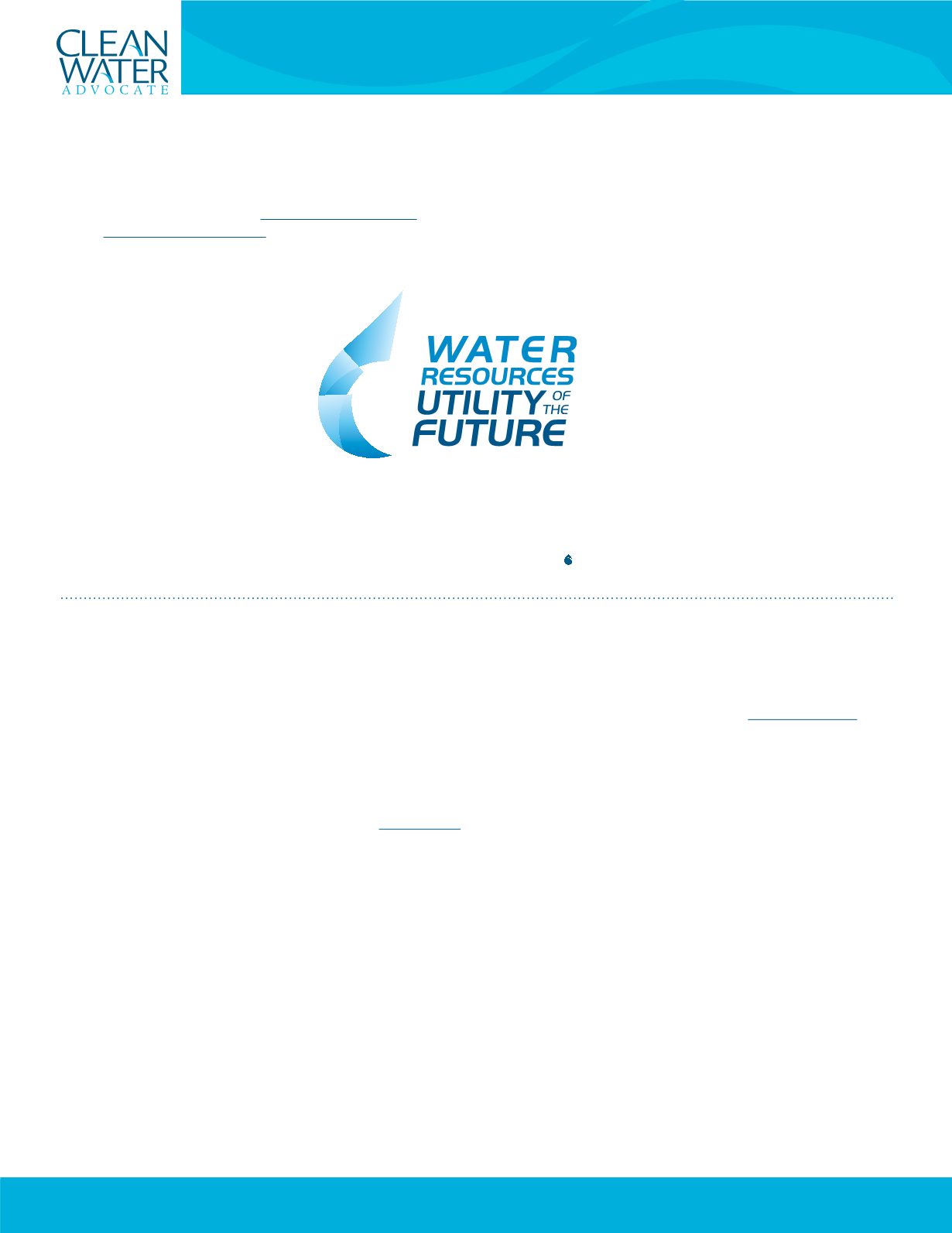
3
F
ollowing the release of the
Water Resources Utility of the
Future. . . Blueprint for Action
in January, NACWA, the Water
Environment Research Foundation (WERF) and the Water
Environment Federation (WEF) have advanced the priorities
set out in the
Blueprint
through research,
advocacy, communications and new ini-
tiatives. The organizations are joining
forces again under the Utility of the Future
(UOTF) banner to advance a shared agen-
da on energy-water nexus issues – one of
the top priorities outlined in the
Blueprint
.
WERF will be leading a project, with the
support of NACWA and WEF, to position
the wastewater utility community as a vi-
tal component of the Nation’s push toward energy independence.
Specifically, the project seeks to provide input to the Department
of Energy (DOE) as it works on a plan to prioritize energy-water
nexus-related program activity. The DOE plan will ultimately
be presented to Congress as a roadmap for the Administration’s
energy-water policy activities. NACWA, WERF, and WEF believe
that the sector is in a unique position to impact US energy policy
and to ensure that energy conservation and production capacity at
wastewater treatment plants plays a central role in future discus-
sions. According to initial analyses, there is a potential for clean
water agencies to produce between 2% and 12% of
the Nation’s energy needs. The collaborative proj-
ect seeks to add some additional specificity to these
statistics – and also provide information on the
wastewater sector’s ability to produce energy, as
compared to other clean energy producers, such as
wind and solar.
At NACWA’s Summer Conference in Cincinnati,
the Association’s Board approved the collaborative
energy-water nexus project, which will help make a
compelling case to DOE that energy conservation and production
from clean water agencies should be a key element of any ongoing
energy-water nexus program planning. The project is in its initial
phase but is being fast-tracked for completion in the late summer
or early fall.
Water Resources UOTF Partners Move Forward on
Energy-Water Nexus
2
W
t
ith NACWA remains focused on assisting clean
water utilities in the implementation of the U.S.
Environmental Protection Agency’s (EPA)
Integrated
Planning Framework.
As a main component of its on-
going efforts, the Association will hold its fifth and sixth collabora-
tive Integrated Planning (IP) workshops this fall. NACWA is also
urging Congress to provide funding for IP community pilots in the
fiscal year (FY) 2014 EPA budget – and has developed a
resource page
with valuable information for utilities pursuing IP goals.
IP Workshops Planned in Regions 1 & 2
NACWA and the Association of Clean Water Administrators
(ACWA), in conjunction with the New England Interstate Water
Pollution Control Commission (NEIWPCC) and the New York
Water Environment Association (NYWEA) have begun planning
for two upcoming IP workshops in Regions 1 (in early September)
and 2 (in mid-November), respectively. Past IP workshops have of-
fered a unique opportunity for communities to candidly talk with
their regulators about how to best tap into the Agency’s promise
of greater flexibility. NACWA members, EPA staff, and state regu-
lators will be invited to attend. The focus of the workshops is
anticipated to be how some of the most challenging aspects of in-
tegrated planning – dealing with affordability and sequencing, for
example – can be addressed using the
Framework
. The Association
will continue to work with ACWA, WEF and its Member Agencies
to plan workshops in additional regions throughout 2013. Those
interested in participating may register on
NACWA’s website.
NACWA Helps Secure Funds for IP Pilots in
House Appropriations Bill
NACWA was instrumental in securing $2 million in the FY 2014
House EPA appropriations bill to establish an integrated plan-
ning pilot program – providing funding to communities who want
to draft integrated plans. The funding would be distributed to
communities in each EPA region, ensuring that this new model
for meeting Clean Water Act obligations has the opportunity to
be effectively tested and evaluated. The House offered strong
bi-partisan support for this program, including an April letter
written by Representatives Bob Gibbs (R-OH) and Tim Bishop (D-
NY), Chair and Ranking Member of the House Water Resources
& Environment Subcommittee, urging House appropriators to
include funding for this program as they constructed a budget
for EPA. While the release of the House EPA appropriations bill is
only the first step in a lengthy process to finalize a FY 2014 budget,
it is clear Congress understands the need for, and value of, the inte-
grated planning approach.
NACWA Plans Integrated Planning Workshops,
Promotes Pilot Program
CONTINUED ON PAGE 6
»


